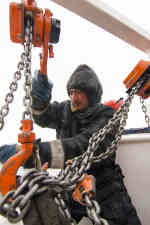Step 4 of 5•5 minutes read
PPE and PPC
Personal Protective Equipment (PPE) and Personal Protective Clothing (PPC) are extremely important when working in such conditions. To avoid frostbite and hypothermia, the crew must know how to dress to get the best protection against the cold.
As far as possible, when working on deck, it is important to work with your back towards the wind. In such environments, safety gloves must insulate, safety glasses should not fog up, and safety shoes must protect against frostbite.
Wet skin freezes faster than dry skin. While working, it is natural to sweat; with that said, it is important never to remove clothing in an exposed environment. Instead, go indoors to dry off. Using breathable clothes or clothes with ventilation decreases the risk of sweat. Several layers of clothing, instead of one heavy suit, are preferable as air trapped between layers of clothing provides better insulation and, consequently, a reduction in loss of body heat.
Wear mittens instead of gloves, and make sure that you wear wind-proof, water-resistant many-layered clothing and two pairs of socks. Underclothing under wind and waterproof upper layers give the best protection.
To get the best protection, wear wool or other functional underclothing next to the skin rather than cotton. Remember, clothes by themselves do not heat the body. The body is warmed up by its heat generation, thus, in turn, warming the layers of air trapped between the skin and the clothing.

Make sure that hoods and caps are worn with ears fully covered. Photo: Jörgen Språng.
Multiple Layers of PPC
To protect the crew from injuries from cold environments, the company must provide them with the appropriate personal protective clothing (PPC) and personal protective equipment (PPE). The work gear for such conditions must include multiple layers, an inner, middle, and outer layer. This creates air pockets between the clothing layers which trap the air, providing insulation.
The inner layer should preferably be made of polyester or silk. These are materials that draw moisture away from the skin. If the moisture is not properly drawn from the skin, then the insulation of the clothing is decreased by up to 50%, hence the importance of having an appropriate first layer of clothing.
The second layer of clothing should be wool or fleece, and the final layer (outer) should be wind and waterproof.
The provided PPE should be compatible with such clothing, and sized to fit over all layers to provide maximum protection.